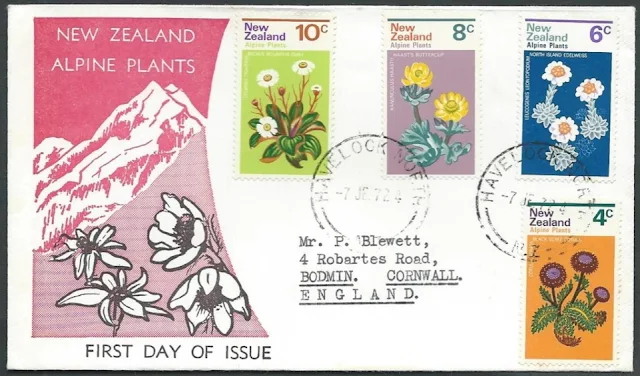This stamp issue was a very hard one to place. Many catalogues place it in the scenic series but since there was already a scenic issue for 1972 we've decided just to treat it as a one off issue.
This set of stamps depicts four of New Zealand's alpine plants. Alpine plants are able to survive the harsh conditions of their mountain environment. In many cases the plant survives under thick snow to burst forth in summer to quickly grow flower and prepare for another long winter.
I like these four stamps, their bright colours and flowers as their subjects.
This set of stamps depicts four of New Zealand's alpine plants. Alpine plants are able to survive the harsh conditions of their mountain environment. In many cases the plant survives under thick snow to burst forth in summer to quickly grow flower and prepare for another long winter.
I like these four stamps, their bright colours and flowers as their subjects.
4c - The Black Scree Cotula (Cotula atrata)
Found in Marlborough and Canterbury at heights of between 1,200 to 2,000 metres, this is one of the commonest scree plants in drier mountainous regions. The flowers seem to be almost black with the pollen appearing as a ring of golden dots.
Found in Marlborough and Canterbury at heights of between 1,200 to 2,000 metres, this is one of the commonest scree plants in drier mountainous regions. The flowers seem to be almost black with the pollen appearing as a ring of golden dots.
6c - The North Island Edelweiss (Leucogenes Leontopodium)
Found from Mt Hikurangi near East Cape southwards to some localities of the South Island. Its golden flower is surrounded by densely woolly white leaves make this plant conspicuous in stony alpine herbfields between 1,200 to 1,800 metres.
Found from Mt Hikurangi near East Cape southwards to some localities of the South Island. Its golden flower is surrounded by densely woolly white leaves make this plant conspicuous in stony alpine herbfields between 1,200 to 1,800 metres.
8c - Haast's Buttercup (Ranunculus Haastii)
Found on screes (steep slopes of loose angular stones) from Nelson to Otago and Western Southland on the drier mountain slopes from 1,000 to 2,000 metres. This buttercup has glistening flowers on thick stalks and succulent grey-green leaves.
Found on screes (steep slopes of loose angular stones) from Nelson to Otago and Western Southland on the drier mountain slopes from 1,000 to 2,000 metres. This buttercup has glistening flowers on thick stalks and succulent grey-green leaves.
10c - The Brown Mountain Daisy (Celmisia Traversii)
Found on the mountains of Nelson and also in Fiordland mainly in moist, snow tussock herbfields between 900 to 1,500 metres. The furrowed leaves are rich blue-green, felted beneath with russet wool. The leaf stalks are purple while the flower stalks are clothed in russet wool.
Found on the mountains of Nelson and also in Fiordland mainly in moist, snow tussock herbfields between 900 to 1,500 metres. The furrowed leaves are rich blue-green, felted beneath with russet wool. The leaf stalks are purple while the flower stalks are clothed in russet wool.
Here is a small collection of four First Day Covers.
Both of these first two covers were sent overseas. The top one went to Australia while the lower one went to England. In both cases the mountain seen in the cover design looks as if it could be Mount Cook, the highest mountain in New Zealand.
The cover above was a local one sent to Hastings. The design shows each of the four flowers seen on the stamps.
Below is a cancelled but unaddressed cover.
The 4c stamp on the First Day Cover above shows the orange background covering the white text. This seems to have been a problem with this stamp as I quickly found another two examples, on a joined pair and attached to a cover. One of the problems with this kind of design where text is inserted into a block of colour is that if too much ink is applied the colour will begin to full in the white of the text, as have happened here.
Technical information
Date of Issue:
|
7 June 1972
|
|---|---|
Designers:
|
E Mayo, Dunedin
|
Printers:
|
Harrison and Sons, England
|
Stamp Size:
|
24.13mm x 40.64mm
|
Sheet Size:
|
100 stamps per sheet
|
Process:
|
Lithography
|
| Perforation Gauge: |
13 x 13.5
|
Paper Type:
|
Chalk surfaced, unwatermarked
|
Some of the images in this post were used with permission from the illustrated catalogue of StampsNZ
You can visit their web site and On-line Catalogue at, http://stampsnz.com/
Information for this post came from.










We appreciate your engagement with our content. To ensure a respectful and constructive community, please take note of the following:
- No Spam, Please: We do not tolerate spammy or promotional comments. Any such comments will be promptly removed.
- Moderation in Place: All comments are moderated to maintain a positive and inclusive environment. Please be patient, as it may take a little time for your comment to appear.
- Sign In with Google: To comment, please sign in using your Google account. This helps us maintain the integrity of our community and allows for better interaction.